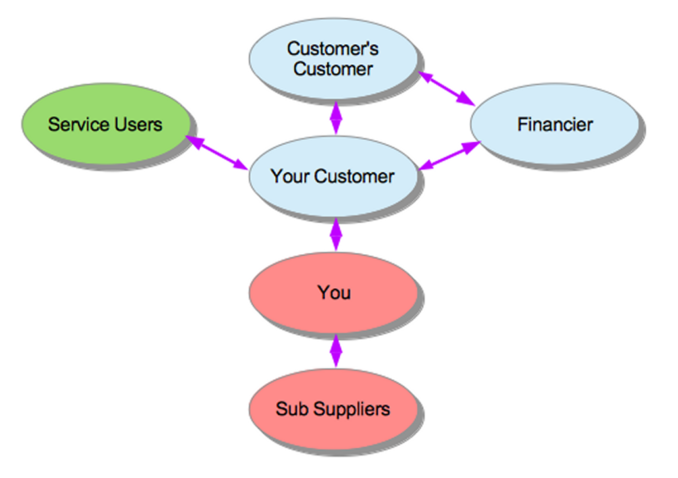In every bid process it is important to identify who you are dealing with, the first is pretty obvious – your customer, or potential customer at least. Keep them sweet, give them what they want at a price they will accept and job done right?
Wrong..
There are a few more players involved as outlined below

Your Customer
This is the organisation you are hoping to sell something to, they will tell you what they want, and what they want from you as a submission. They are not however the only player in the game here that you need to be aware of.
Typically your customer is selling their services up the chain. For example say you make and sell busses, you will typically be selling to a franchise operator as your customer, they are selling to whoever licenses the franchise.
This means you need to understand what your customer wants, not all of which they will tell you, or even be fully aware of themselves, but also what their end customer wants.
They key here is to make your customers life as easy as possible by helping them sell to their customer.
Your Customer’s Customer
This is the organisation your customer is selling to, they will have their own objectives – for example a public authority will be concerned about price but will also want to know how this project helps other agendas they have, diversity, environment, local employment etc.

Matthew Kenwrick – Licence CC BY-ND 2.0
It is important to know who the this is, and indeed who their customer is – this is a job for your sales and business strategy teams who should be aware long before the process formally starts who these organisations are and what they place value on.
Typically a submission is scored against a score card, you will likely see the one your customer is using – a fair chunk of which will relate to the one they are being scored on, this is where all the questions related to “what proportion of your employees are BAME?” come from (Black, Asian or Minority Ethnic) – the trick is working out just how important this sort of thing it.
Financier
This is an unusual one, a lot depends on the organisation concerned and the relationship between them, your customer and their customer – you need to be aware of this, some examples:
- A bank, typically a bank is providing money and otherwise is reasonably hands off, they will likely want some assurance about the life span of the asset they will be buying and how likely they are to be able to secure revenue longer.
- A leasing house, this is an intermediary, they may be part owned by a bank, here they are buying your product, then leasing it back to your Customer or their Customer for a periodic payment. Expect them to be a lot more hands on as they will want to make sure they have the longer term revenue stream. Often a lot of the financial questions will come from this organisation.
- Government or Local Authority, in some ways the best, in other ways the worst option from your point of view. While its not their money as such they tend to ask a hell of a lot of questions because they have a standing army of people to ask such questions
- Self Funding – here a company is buying something themselves using their own money or financing as part of a larger operation. This from your point of view is the best option as its nice and simple.
You need to know how this is being managed as this determines how you “pitch” the prices you offer.
Key Learning Point: understand what the organisation providing the money views as important

Images Money – Licence CC BY 2.0
Service Users
For example bus passengers, while they do not have any real say in the purchasing decision it is well worth taking account of what they want or are likely to want as if you can meet these you are helping your customer sell their services, and helping your customer makes them more likely to want to work with you.

Sigfrid Lundberg – Licence CC BY-SA 2.0
Key Learning Point: if you know what the end user wants it may make understanding what you are being asked to provide easier to understand, and easier to sell.
Identify the problem
Your customer has a “problem” they want to be solved, it is very important to realise what this is and to have this as your focus. For example to stick with our busses. Your customer has approached you wanting to buy a number of busses.
However they don’t want to buy busses, they don’t buy them for the sake of it, the problem they have is likely to be a need to provide a service and not having enough busses currently to do this.
As a result your product is not a bus or several busses, your product is providing a solution to the problem. Your focus needs to be on how your product allows the customer to provide the service they want to.
For example, your customer wants to buy say 20 busses to provide a service, you may be able to get a significant advantage by finding a way to provide the same level of end service with only 19 busses (perhaps they are more reliable, or have a higher capacity or something else). You will need to talk to the customer about this as you need to offer what they have asked for, but if you can say “there is also this alternative solution which is better for you, and this is why…” it can impress and at the very least peak a customers interest.
Key Learning Point: what you are selling may not be what you think you are selling, you are selling a solution to a problem, keep this in mind and make sure those around you know this.
Key Objectives
You, as a bid manager for an organisation bidding for a project need to identify the key objectives, you do this by taking note of what you have learnt from the above:
- Customers requirements
- Customer’s Customer requirements
- Financier requirements
- Service user requirements
- your requirements
The last one is very important to keep in mind, e.g. you may have a lull in work coming up so a key requirement is to fill that lull, perhaps by offering a discount.
These should be discussed within the team to define what you will consider “key”, some will be contradictory and you will need to decide how you will manage this.
Customers Tendering Team
These are the people you will deal with during this process, typically you will have a single defined point of contact, and the customer will take a very dim view of you trying to go around this – once a bid process starts they typically have some strict rules they will have to comply with and you trying to talk direct to their operations team can put a project at risk.
As such you need to know this individual well, and those around them, learn the hours they work, a personal business relationship is good here – you want them to know you and to be able to give them a call to clarify any issues.
One thing that cannot be stressed enough, don’t piss off the customers tendering team, these are the people who will be marking your homework, its very easy for them to make sure you come no better than second if they don’t like you. Ideally you should be working to make their job as easy as possible.
An example from real life, a customer had a pricing sheet they wanted filling in, they provided this as a Microsoft Word document. I made a phone call to note Microsoft Excel may be slightly more useful for some parts of the evaluation and would it be ok for us to supply both? Result a happy customer who hadn’t actually thought about how they would be assessing that part.
This will also assist in identifying previously unidentified issues, we will look at this later.
Key Learning Point: get the customer’s tendering team to be your sales lead within the customers organisation, make their life as simple and painless as possible, make them feel important.
Organisation
It is worth getting to know how your customer is organised, the scale of the project relative to their scale of operations matters here – this informs you who is likely to be making the actual decision and thus who your sales team should be taking to before the process starts, and once you have submitted she they should be talking to, off the record, to influence the outcome.
Knowledge of the customers internal politics also helps, e.g. will their finance team have a leading role here or will they be told to “make it work” as long as its within the budget? what about their safety team? their operations team? Will their board be more concerned with public virtue signalling? do they have any policies you can take advantage of – e.g. “buy local”?
Part 2 conclusion
As you can see there is slightly more to selling something to someone that knowing them, you need to be aware of the larger network of those involved and how it all interacts.
In part 3 we will move to look at you and your organisation and how that impacts the process of bidding for work, the individuals involved and how you can make your life easier or a lot harder.
© Leopard 2018
Audio file



